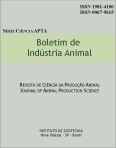Growing hairs in shorn cattle
Keywords:
cattle, hair, shearingAbstract
The shearing operation can provide double benefits to the cattle: they can become more heat tolerant and the tick infestation decreases. The cattle tick Rhipicephalus (Boophilus) microplus causes great losses to dairy cattle, especially to the Holstein cattle because they are very susceptible to this tick. Its control is becoming each day more difficult, owing to the increasing resistance to acaricides they are acquiring. The objective of this work was to study the growing of haircoat following shearing. We made our experiment with 17 animals, 7 females and 10 males. They were shaved on the anterior third (head, neck, dewlap, scapula and arm) of one side, at random. The work was performed in two steps: they were shorn for the first time on August 2nd 2012, with a size 10 blade in a clipper Oster model GoldenA5, which left the fur coat 2 mm long. Then we evaluated the hair length growing by collecting fortnightly three sample of hairs in the middle of the scapula, with electric pliers, modified for this purpose, in both sides of the animals, sheared and non-sheared, until 30 days after this shearing. The three hair samples were put inside a little plastic bag per animal. Meanwhile, as we thought that the animals shearing had to be done closer to the skin, we decided to shear them again (in the same side shorn before), on October 2nd 2012. We changed our procedure using the same machine, but now with a blade size 30, which left the fur coat 1mm thick. After that, we collected again, fortnightly, samples of hairs on both sides during 2 months. The 10 longest hairs in the plastig bag were measured using a graph paper and the average per animal was calculated in each data and blade. A random design was applied for statistical analysis, the hair length of both sides, sheared and non sheared were compared by a two related samples tests €“ Wilcoxon, in a non parametric test, using the SPSSP 12.0 program, in each data within each blade. Using blade size 10, hair decreased from average 21.26 ± 5.72 mm to 4.50 ± 0.83 mm. On the sheared side a hair growth of 26 mm was observed during the first two weeks, increasing to 40 mm for the next two weeks and at the end of 28 days there was still a significant difference (Z= -3.195; P= 0.001) for the non sheared hair (19.42 ± 7.33 mm) and sheared hair (11.15 ± 3.23 mm). Such procedure was done by the beginning of August, still winter time. Using the blade size 30, sheared hair had an average of 4.76 ± 1.1 mm. A 24 mm hair growth was observed for the first two weeks and 20 mm for the next two weeks, decreasing its growth speed to 9 mm and after 57 days no significant difference was observed between sheared side (11.47 ± 5.61 mm) and non sheared side (14.78 ± 8.06 mm, Z= -1.915; P= 0.055). Second cut was performed by the beginning of October, spring time, period where there is a change of hair in European cattle from winter season (thin and long hair) to summer season (thick and short hair), starting on spring time. In this work we could observe the fast growing of hair when cut was done in winter time and the closer to the skin the better the benefits to the animals, as heat tolerance and fewer tick infestations. If shearing is done in spring time, it must be every 45-50 days.Downloads
Downloads
Published
Issue
Section
License
Os autores não serão remunerados pela publicação de trabalhos, pois devem abrir mão de seus direitos autorais em favor deste periódico. Por outro lado, os autores ficam autorizados a publicar seus artigos, simultaneamente, em repositórios da instituição de sua origem, desde que citada a fonte da publicação original seja Boletim de Indústria Animal. A revista se reserva o direito de efetuar, nos originais, alterações de ordem normativa, ortográfica e gramatical, com vistas a manter o padrão culto da língua e a credibilidade do veículo. Respeitará, no entanto, o estilo de escrever dos autores. Alterações, correções ou sugestões de ordem conceitual serão encaminhadas aos autores, quando necessário. Nesses casos, os artigos, depois de adequados, deverão ser submetidos a nova apreciação. As opiniões emitidas pelos autores dos artigos são de sua exclusiva responsabilidade. Todo o conteúdo deste periódico, exceto onde está identificado, está licenciado sob a Licença Creative Commons Attribution (CC-BY-NC). A condição BY implica que os licenciados podem copiar, distribuir, exibir e executar a obra e fazer trabalhos derivados com base em que só se dão o autor ou licenciante os créditos na forma especificada por estes. A cláusula NC significa que os licenciados podem copiar, distribuir, exibir e executar a obra e fazer trabalhos derivados com base apenas para fins não comerciais.













